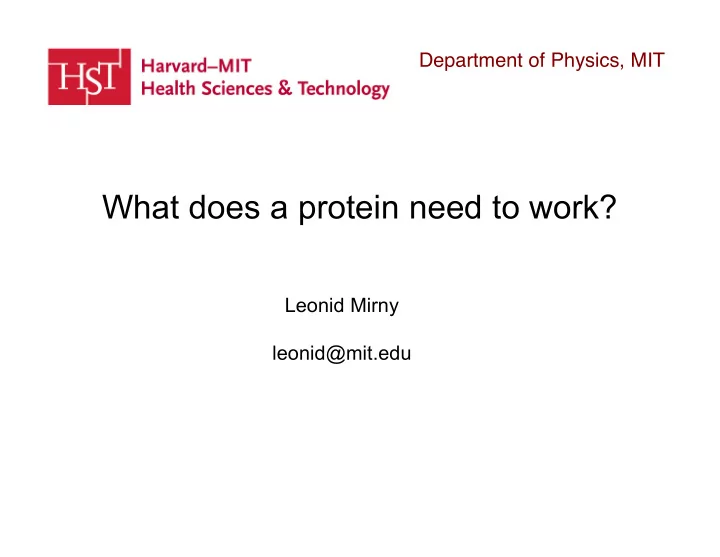

Department of Physics, MIT What does a protein need to work? Leonid Mirny leonid@mit.edu
What does a protein need to work? 1. Stable structure 2. Specific active/binding sites.
What does a protein need to work? 1. Stable structure 2. Specific active/binding sites. 3. Somewhat unstable structure 4. Non-specific binding site
A simple DNA-binding protein Function 1. Find its site on DNA 2. Bind it tightly 3. IF [ligand]>0 leave the site ELSE goto step 1. END
A simple DNA-binding protein Function 1. Find its site on DNA 2. Bind it tightly 3. IF [ligand]>0 leave the site ELSE goto step 1. END
Problem 1: find cognate site among 10 6 -10 9 non-cognate sites
WATER CELL Experiment: Riggs et al 1970 k on ≈ 10 10 M − 1 s − 1 k on ≈ 10 10 M − 1 s − 1 t a ~ 1 − 10 sec t a ~ 10 2 − 10 3 sec Diffusion-limited association Theory: 1D diffusion (“sliding”) + 3D Richter and Eigen 1974, Berg, Winter, von Hippel 1981
Model: 1D+3D ..CATGTT CAGGCA CGTAGC... n τ 1 d τ 3 d t s – search time M – genome size
Model: 1D+3D ..CATGTT CAGGCA CGTAGC... n τ 1 d τ 3 d
Our model: 1D+3D ..CATGTT CAGGCA CGTAGC... σ Energy landscape of 1D sliding
Protein-DNA interaction energy l DNA-binding domain ∑ E = e ( i , b i ) DNA i = 1 Energy is strongly sequence dependent Energy landscape CATGTTTTATAT CAGGCA CATGCGGCAGTCA NO ENERGY GAP σ between cognate and random sites
Results Fast sliding requires smooth landscape σ smooth 4 ( σ / kBT )2 rugged 7 1 d ~ e − D Roughness of the energy landscape
Results Specific recognition requires rough landscape FRACTION OF TIME SPENT ON THE COGNATE SITE σ smooth rugged Roughness of the energy landscape
Speed-stability paradox FRACTION OF TIME SPENT ON THE COGNATE SITE STABILITY: σ >5 >5 kT SPEED σ <2 <2 kT Either speed or stability but not both ! Slutsky.M, Mirny,LA, Biophys J ( 2004)
Proposed Mechanism
Proposed Mechanism T SEARCH MODE RECOGNITION MODE
Experiments Experiment Kalodimos et.al Science.2004
Structure and animation by Babis Kalodimos et al
Landscape model ATCATGCATGCCAGTCAGCTCAG Reaction coordinate Reaction coordinate
Meso-scale dynamics of landscape model Log(t(x,z))
Macroscale dynamics 10 3 Total search time (sec) 10 2 Experimental folding rate Correlated Correlated landscapes landscapes 10 1 Folding time (sec) flat landscape flat landscape model model
Summary 1. 1D+3D search is fast if the protein-DNA complex is FLEXIBLE. 2. Conformational transition in the DNA-binding protein controls the search time.
Somewhat unstable structure is needed for … Function 1. Find its site on DNA 2. Bind it tightly 3. IF [ligand]>0 leave the site ELSE goto step 1. END
What does a protein need to work? 1. Stable structure 2. Specific active/binding sites. 3. Somewhat unstable structure 4. Non-specific binding site
What does a protein need to work? 1. Stable structure 2. Specific active/binding sites. 3. Somewhat unstable structure 4. Non-specific binding site
Model: 1D+3D ..CATGTT CAGGCA CGTAGC... τ 1 d τ 3 d
Model: 1D+3D ..CATGTT CAGGCA CGTAGC... Ε ns σ Energy landscape of 1D sliding
Results Fast sliding requires optimal non-specific binding Ε ns σ more more jumping sliding Free energy of non-specific binding
Non-specific binding is needed for … Function 1. Find its site on DNA 2. Bind it tightly 3. IF [ligand]>0 leave the site ELSE goto step 1. END
Equilibrium M~10 6 - non-specific sites m~10 - number of LacI proteins per cell 1 ns ≈ 10 − 6 M K d P = s s , NO − LIGAND ≈ 10 − 12 M 1 + M K d K d s , LIGAND ≈ 10 − 9 M ns K d m K d 1 P NO − LIGAND = 1 + 0.1 = 0.9 Fraction of time the site is bound 1 P LIGAND = 1 + 100 = 0.01
Non-specific binding is needed for … Function 1. Find its site on DNA 2. Bind it tightly 3. IF [ligand]>0 leave the site ELSE goto step 1. END
Summary 1. 1D+3D search is fast if the protein-DNA complex is FLEXIBLE. 2. Conformational transition in the DNA-binding protein controls the search time. 3. Non-specific binding is essential for protein function.
What does a protein need to work? 1. Stable structure 2. Specific active/binding sites. 3. Somewhat unstable structure 4. Non-specific binding site
Testable predictions 1. Diffusion of a protein on DNA is sequence- dependent. 2. DNA sequences can influence - folded/unfolded equilibrium - rate of conf.transition in the protein (nucleate folding on the target site) 3. Mutations that change the stability and rate can have affect on the total search time and timing of gene expression.
Department of Physics, MIT Acknowledgements Michael Slutsky, MIT Physics
Recommend
More recommend